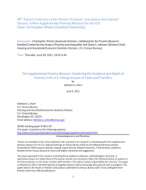The Supplemental Poverty Measure: Examining the Incidence and Depth of Poverty in the U.S. Taking Account of Taxes and Transfers
The Supplemental Poverty Measure: Examining the Incidence and Depth of Poverty in the U.S. Taking Account of Taxes and Transfers
Abstract
This paper lays the groundwork for preparing estimates of a Supplemental Poverty Measure for the U.S. at the Census Bureau. Estimates presented here are based on the CPS 2010 ASEC and refer to calendar year 2009. Results show poverty rates for the official poverty measure, the research SPM, and a relative measure of poverty. The research SPM results in slightly higher poverty rates than the official measure for most groups, the relative poverty rates were the highest. In addition, the distribution of people in the total population and the distribution of people classified as in poverty using the two measures are examined.
Other findings show that the SPM allows us to examine the effects of taxes and in kind transfers on the poor and on important subgroups of the poverty population. As such, there are lower percentages of the SPM poverty populations in the very high and very low resource categories than we find using the other measures. Because noncash benefits help those in extreme poverty, there were lower percentages of individuals with resources below half the SPM threshold. FGT indexes showed lower poverty gaps and poverty severity using the SPM than either the official or the relative measures. These findings are similar to those reported in earlier work using a variety of experimental poverty measures that followed recommendations of the NAS poverty panel (Short, 1999, 2000, and 2001).
Tables
Others in Series
Working Paper
Working Paper
Working Paper





